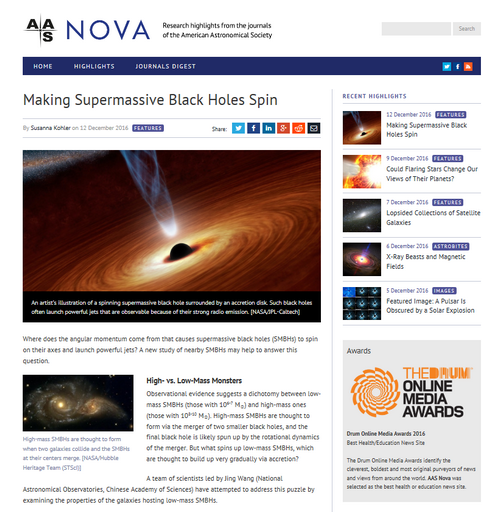AAS NOVA, an official web site of American Astronomical Society (AAS) for highlights from the journals of the AAS, has reported a study on the origin of spin of supermassive black holes (SMBHs) in Dec 12, 2016, which was contributed by Dr. Jing Wang and collaborators from National Astronomical Observatories of CAS ( http://aasnova.org/2016/12/12/making-supermassive-black-holes-spin/). The study has been published in The Astrophysical Journal Letters. It is supported by National Natural Science Foundation of China.
Observational evidence suggests a dichotomy between low-mass SMBHs (those with 106-7 M☉) and high-mass ones (those with 108-10 M☉). High-mass SMBHs are thought to form via the merger of two smaller black holes, and the final black hole is likely spun up by the rotational dynamics of the merger. But what spins up low-mass SMBHs, which are thought to build up very gradually via accretion?
In order to address the puzzle, Wang and collaborators at first constructed a sample of 31 radio-selected nearby Seyfert 2 galaxies with low-mass SMBHs at their centers. Instead of being overwhelmed by continuum emission from the galaxy’s active nucleus, the stellar population and morphology of the host galaxy are visible to us in those galaxies. The mass of SMBH of those galaxies were measured by using the surrounding stellar dynamics. They subsequently analyzed the surface brightness profile of the host galaxies of the 31 selected Seyfert 2 galaxies.
With the analysis, Wang and collaborators discovered an intriguing relationship for the first time: the radio power of jets launched by an SMBH appears to be dependent upon its host galaxy’s bulge surface brightness. Wang and collaborators found that more powerful radio emission comes from SMBHs associated with less-concentrated bulges, i.e. those that are more disk-like.
After rule out many common explanations for the radio-loudness of such galaxies with small SMBH masses, Wang and collaborators pointed out that the spin of high-mass SMBHs and low-mass SMBHs has entirely different mechanisms: low-mass SMBHs are spun up by the accretion of surrounding gas, while high-mass SMBHs are spun up by the BH-BH mergers. This result strengthens the dichotomy between low-mass and high-mass SMBHs, supporting the idea that the two categories of black holes are indeed formed via completely different mechanisms.

The Study Reported on American Astronomical Society Website













